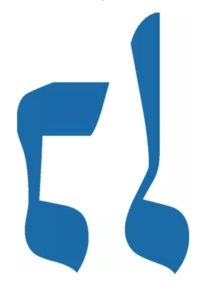Raboyseyee and Ladies,
We begin with another shout out -the big one- on the upcoming wedding -starting just about now as this week’s Toirah gets disseminated- to Marni Gottesman on her upcoming wedding to Jake Gerber. Mazel tov to friends of many decades Judith and Shlomo Gottesman who will be walking Marni down the aisle to the chuppah. We have known Marni since birth and watched her develop into the fine young and elegant lady she is today. A very special mazel tov as well to Jake’s parents, Tracy and Sander Gerber, they of the upper West Side and to their entire extended family. A very special mazel tov shout out to grandmothers Sondra Gottesman & Blanche Lerer; may you have much nachas and joy from Marni and Jake. May Marni and Jake merit to enjoy many decades of blissful marriage. The Ois and eishes chayil are on their way and looking forward to participating in this great simcha.
As well, we shout out a big mazel tov Miriam and Judah Perlstein upon the wedding this past Tuesday -with the Ois and eishes chayil sadly absent- of their beautiful daughter Talia who married Yonah Cohen, he of Lawrence New York. The heylige Ois has known this kallah since birth, her sisters, and the entire family for many decades and wish the entire Perlstein family only boatloads of nacahs from Talia and Yona and their other children and grandchildren. Mazel tov as well to the honored grandparents on both sides and to both extended families. May Talia and Yona merit to enjoy many decades of blissful marriage. We look forward to joining the Perlstein’s this coming motzei shabbis as the celebration continues.
———————————————————————————————————————
The Wheels on the Bus, Celibacy, Jealousy, Upside Down Nunns
Welcome to Parshas Bihaloischo, or is it? Having returned late last night from a seven-day river cruise around parts of Europe where the eishes chayil and the heylige Ois joined another 160 or so people -mostly from Israel but a good handful from Chtuz Lo’oretz (England the U.S.) and after -under the supervision of well-known rabbis- we lained Parshas Bihaloscho on the ship last Thursday and S’hlach, this past Monday, the Ois remains confused: which parsha was it, or is it, this week? Though I have previously written about how those in Israel will remain one week ahead until the end of Bamidbar, who knew that Israeli’s traveling abroad on the high seas and rivers, bring their own parsha with them. As the Ois’s father would say: a naya zach. In English: live and learn new things daily.

Speaking of new things, the Ois begins this week with an admission. This week’s post on Parshas Biholoichso -seemingly read on dry land all over America and other countries- is a shtikel repeat of what was posted back in 2015. Why? The emes is azoy: the intentions were to set aside proper time while cruising and to write a brand-new review, ober the Ois was too busy meeting new people on the shiffel (boat), schmoozing with those he met on days one and two, analyzing -as did kimat all others- each and every person he and the eishes chayil met -or didn’t, and mistama also sneaking in a few words of loshoin horo -real or not- about certain individuals. Bottom line: guilty as charged. Not to worry: Miriam, one of the central characters in our parsha did the same, and survived; more below. Ober there taka were mitigating factors: ershtens, kimat all others were doing the same. Moreover, the sights along the Danube River were too beautiful to walk away from. The Ois apologizes profusely, and will be back next week with brand new information including a personal story about cousins from Vienna cousins he discovered in Vienna but has yet to meet. Moreover, he knows with certainty that few of his readers recall what was written back in 2015. Grada, one gentleman – a new subscriber- asked if the Ois repeats the contents from year to year and the Ois maintained adamantly that over the past twelve years which come to an end in the beginning of Sefer Devorim, only a handful of times has he bastardized his own works. This is one example but updated for 2022.
 It so happens that Parshas Bihaloischo has always been a favorite of the Ois davka because it brings back childhood memories. As mentioned, it contains the famous and oft talked about upside down nunns. The nun is, for those who don’t know, a Hebrew letter which happens make the letter ‘n’ sound, and typically has a numerical value of 50. It’s most well-known for adorning every dreidel but is famous in the heylige Toirah for appearing, as we stated, upside down. Not once, but twice, and the nuns are bookends for two special -efsher misplaced- pisukim which, time and space permitting, we will or won’t address soon. Ober, altz kind (lad), the upside-down nunns, were worth 500 points each in the game of chumish which we played over and again though our fathers were constantly excoriating us to say a few words in the siddur. Does everyone agree? Not! Some say the nun is valued at 1000 points. Bottom line: if you landed on this parsha and found the nuns during your turn, you were an instant winner. And if you happen to have mentioned this to your yeshiva rebbe, he might have selected you for some personal hugging and chapping, if you chap. Shoin.
It so happens that Parshas Bihaloischo has always been a favorite of the Ois davka because it brings back childhood memories. As mentioned, it contains the famous and oft talked about upside down nunns. The nun is, for those who don’t know, a Hebrew letter which happens make the letter ‘n’ sound, and typically has a numerical value of 50. It’s most well-known for adorning every dreidel but is famous in the heylige Toirah for appearing, as we stated, upside down. Not once, but twice, and the nuns are bookends for two special -efsher misplaced- pisukim which, time and space permitting, we will or won’t address soon. Ober, altz kind (lad), the upside-down nunns, were worth 500 points each in the game of chumish which we played over and again though our fathers were constantly excoriating us to say a few words in the siddur. Does everyone agree? Not! Some say the nun is valued at 1000 points. Bottom line: if you landed on this parsha and found the nuns during your turn, you were an instant winner. And if you happen to have mentioned this to your yeshiva rebbe, he might have selected you for some personal hugging and chapping, if you chap. Shoin.
 Let’s learn some parsha. We’re all familiar with the song ‘the wheels on the bus go round and round…….ober this week, the wheels on the Yiddin’s bus into the Promised Land- metaphorically speaking avada- are about to become unglued. It could be argued that they fell off mamish two weeks back, when we began Sefer Bamidbar (the book of numbers) with a census. Rashi and others told us the RBSO counted the Yiddin often because he liked -even loved- them. That was then! This week, He’s not in a loving mood and by the time we get to the end of the parsha wherein we will, among other interesting topics, also be reading about the kvetching and complaining against the RBSO, against the Yiddin by Moishe and against Moishe by his own shvester and brider (sister and brother), the count, though previously certified and audited, will no longer be valid. The RBSO will show His wrath and many will die. Many thousands more meet a similar fate in the coming weeks, oy vey. This is not the first or last time the Yiddin will have upset the RBSO. Previously they were in trouble with the eygel (golden calf). It’s in this week’s parsha and in the coming weeks, that the real mischief begins as we find the Yiddin marching from one calamitous situation into another, each nebech of their own making. Just one year back, the Yiddin witnessed open miracles – many- some, still talked about in today’s times, ober as the good book of Bamidbar will recount, their behavior, efsher due to sheer boredom or maybe as a result of too much sun to their exposed and yarmulke-less heads, spiraled out of control. And why did the RBSO select us to be His Chosen people? Ver veyst! Can you just imagine how poorly behaved the other umois ho’oilom (nations of the world) were?
Let’s learn some parsha. We’re all familiar with the song ‘the wheels on the bus go round and round…….ober this week, the wheels on the Yiddin’s bus into the Promised Land- metaphorically speaking avada- are about to become unglued. It could be argued that they fell off mamish two weeks back, when we began Sefer Bamidbar (the book of numbers) with a census. Rashi and others told us the RBSO counted the Yiddin often because he liked -even loved- them. That was then! This week, He’s not in a loving mood and by the time we get to the end of the parsha wherein we will, among other interesting topics, also be reading about the kvetching and complaining against the RBSO, against the Yiddin by Moishe and against Moishe by his own shvester and brider (sister and brother), the count, though previously certified and audited, will no longer be valid. The RBSO will show His wrath and many will die. Many thousands more meet a similar fate in the coming weeks, oy vey. This is not the first or last time the Yiddin will have upset the RBSO. Previously they were in trouble with the eygel (golden calf). It’s in this week’s parsha and in the coming weeks, that the real mischief begins as we find the Yiddin marching from one calamitous situation into another, each nebech of their own making. Just one year back, the Yiddin witnessed open miracles – many- some, still talked about in today’s times, ober as the good book of Bamidbar will recount, their behavior, efsher due to sheer boredom or maybe as a result of too much sun to their exposed and yarmulke-less heads, spiraled out of control. And why did the RBSO select us to be His Chosen people? Ver veyst! Can you just imagine how poorly behaved the other umois ho’oilom (nations of the world) were?
Next week, we will read about the meraglim (spies) and the shabbis wood-chopper. He will disappear from the script rather quickly. They will be followed in two weeks by Koirach’s rebellion. Thereafter, Moishe will abuse his shteken (stick) in the famous ‘hitting of the rock’ incident which resulted in the cancelation of his Visa into the Promised Land. And of- course you won’t want to miss later events as the Yiddin, some of them anyway, get involved with hot shiksa Midianite, Moabite, and other meydlich while also succumbing to some avoido zoro (idol worship) nuch der tzi (to boot). How many times -over the past twelve years- has the Ois told you that the RBSO mamish abhors the combination of sexual promiscuity when combined with avoido zoro? Many! He can, does and has forgiven the first but never avoido zoro. Shout out to Dovid Hamelech! I repeat: is it not a wonder that the RBSO picked us from all other umois ho’oilom? Can you even imagine what they were up to?
Let us begin at the end of the parsha where the heylige Toirah tells us the very fascinating story of Miriam being stricken with tzora’as (leprosy of some sort) over some gossip incident. The medrish and others will tell us that she turned snow white. The Ois reviewed many midroshim which discuss whether or not Moishe’s wife was a Kushite (maybe black) and whether he had one or more of them. Were both black, or was one black and beautiful and the other, not so? Ver veyst? And taka, as we see below, the Ibn Ezra will tell us that he believes she was homely looking, ver veyst. Avada you should check out the archives here www.Oisvorfer.com. Ober this year, we will focus a sharper lens on the story leading up to Miriam’s leprosy. What happened and what did she do wrong? Don’t millions of people all over the world gossip daily and yet, are not stricken with leprosy? Indeed they do! Lommer lernin inaveynig (let’s see the text) which tells us (Bamidbar 12:2) in the 56 words below (fewer in Hebrew) about the exchange between Miriam and Aharoin that led to her instant punishment and temporary banishment: 1- Miriam and Aharoin spoke against Moishe regarding the Kushite woman he had married, for he had married a Kushite woman. 2. They said, “Has the Lord spoken only to Moishe? Hasn’t He spoken to us too?” And the Lord heard. 3. Now this man Moishe was exceedingly humble, more so than any person on the face of the earth.
Does what Miriam said about her brother Moishe sound so giferlich to you? Don’t most of you badmouth your siblings regularly if not daily? And don’t you include a few expletives while doing so? Is what Miriam said so offensive? Why was she punished so severely and so quickly? Because the heylige Toirah does not tell us what went down behind the scenes leaving us with yet another lacuna, Rashi and so many others fill in the blanks as they imagined them to be. They will tell us that Moishe had a very unique and challenging family situation. Seemingly, because of his unique relationship with the RBSO, he decided to forgo any home-chapping; he was celibate. Shoin! We will be taught that Moishe, because he was either in constant contact with, or on call to the RBSO, took it upon himself to remain spiritually pure at all times. In plain English: to maintain purity and be instantly on call, he was physically and sexually separated from his wife Tzippoirah. Nu, just about now, many of you are may be klerring azoy: What’s the big deal? Though avada not for the same reasons, aren’t many of you leading Moishe’s home life, if you chap? And don’t many of you have a least one chaver that’s living at home but is nonetheless separated from his own wife in that department? Why was this big news?
Though this was avada a private matter between Moishe and his wife, is anything really private? Nu, it so happened -or could have- that Miriam came to know this information and what do most women do when they hear some juicy gossip? The same thing men do; they repeat it! They repeat it to at least one person, usually more. And she heard this from whom? Mistama from her own sister-in-law Tzippoirah when they went out for their daily early morning walk to collect the munn, or, efsher they went out for a stam a stroll in the midbar, ver veyst? Shoin, so far the story sounds quite ordinary. A married couple has no physical contact, if you chap, wife complains about her husband and shoin, the secret is out. On the other hand, it’s not quite so ordinary because more typically, it’s the men gossiping about the lack of home-chapping and each friend knows exactly how much or how little is going on at home. Shoin, let’s not judge the women of today: Maybe they taka believe that their husbands are on call to the RBSO, ver veyst? Some taka wouldn’t mind if the RBSO called for them, oy vey!
In any event, Miriam felt that her little brother’s behavior towards his eishes chayil was a shtikel inappropriate; Miriam repeated to her brother Aharoin the hot news that Moishe, despite being married to a Kushite beautiful woman, was not fulfilling his martial obligations, if you chap. The matter was discussed and it appears from the text as interpreted by many, that they were a shtikel jealous of their brother Moishe. And we know this how? Because the heylige Toirah doesn’t tell us and when the Toirah doesn’t tell us, along comes Rashi, the heylige Gemora, the medrish and many others and each pontificate and give us a view on what might have been said, what they were thinking and why the RBSO reacted. Shoin and now you know why we need to learn not just the heylige Torah as given to us on Shovuis over 3300 years ago, but also the Toirah she-baal-peh, the oral tradition so that we can better chap all the possibilities. Oral always helps! What really happened, ver veyst? What was Miriam really thinking when she complained to Aharoin, ver veyst, ober today we will take a look at what Rashi and the Ibn Ezra had to say. There are of course other views.
Says the Ibn Ezra azoy: Miriam was accusing Moishe of separating from Tzipoirah on account of her appearance. She was ugly! The repeated emphasis on “Moishe had taken” a Kushite woman (see the verses above), indicates that the marriage was in the past, and that something was now wrong. She sensed they were separated if not divorced. Miriam told Aharoin that Moishe was not with her. And, the identification of Tzipoirah as a “dark-skinned woman” instead of by her name, which is the way she appears in the rest of the Toirah, indicates that Tzipoirah’s looks, and specifically her color, was efsher the issue over why Moishe left. Was Miriam a racist? Did she make a racial slur and is that why the RBSO was so upset? Ver veyst? And Miriam’s own words wherein she discussed the fact that she and Aharoin experienced prophecy too, was her way of saying that Moishe had not separated from Tzipoirah for the sake of receiving prophecy. Because she and Aharoin both received prophecy yet maintained normal family relations. Separation then was, in her opinion, obviously not a requirement for the prophetic experience. Hence, it must be that Moishe separated for another reason.

And the bottom line? It appears that calling someone’s wife less than attractive, especially Moishe’s, the RBSO’s favorite of all characters, the one person the RBSO selected for mouth-to-mouth conversations, and telling this to one’s brother was considered loshoin horo and did not sit well with the RBSO. Shoin, she was stricken with leprosy and excommunicated for a total of seven days. She was temporarily cancelled, fartig!
Ober what about Aharoin? Wasn’t he part of the conversation? He was! On the other hand, there is zicher no indication in the text that Aharoin responded or agreed with Miriam; was he too held accountable for the loshoin horo caper? Says the Ibn Ezra azoy: Aharoin played a role, albeit a minor one, in the slander. Miriam was the central speaker and maybe Aharoin was just listening, and it does appear that listening to the loshoin horo was also giferlich though not quite as giferlich as speaking it. Miriam was the instigator. Aharoin was either silent, indicating agreement, or even openly agreed with Miriam. Was Aharoin punished? Ibn Ezra says he was but does not explain how. It seems clear that Aharoin did not receive leprosy. Ober if he wasn’t stricken with leprosy and wasn’t excommunicated, how and where was he punished? Seemingly, the Ibn Ezra believes that Aharoin’s punishment was more in the form of a tongue lashing directly from the RBSO who called a meeting and told both Miriam and Aharoin that bad mouthing Moishe was not a good idea.

Shoin, hakol-bakol (to wrap things up), and before we leave this topic, the heylige Ois once heard a rabbi rationalize Miriam’s gossiping about Moishe separation azoy: Moishe taka separated from his wife to be available to carry out the RBSO’s word. Ober Miriam was still traumatized from a previous separation in her own family. She didn’t know the reason for Moishe’s separation, nor really care. She was just shocked. What taka happened? Nu, efsher you recall that way back in Parshas Shmois, we read the story of how Moishe’s parents, Amrom and Yoicheved, were also separated during the days of slavery in Mitzrayim and it was, according to the medrish brought by Rashi, Miriam who convinced them to reunite. Most kids dream about reuniting separated or divorced parents, ober it’s not always a good thing. And avada you all recall, or should, that it was from this re-union- of Amrom and Yoicheved that Moishe was born. Another medrish will teach us that Yoicheved married someone else while either separated or divorced from Amrom and had two sons who incidentally will be making a Toirah appearance very shortly, ober that for another day. And when Miriam heard that now her own brother was separated, she was nebech tzibrochen (very saddened).
Taka a nice thought and maybe she was taka well intentioned ober the RBSO wasn’t biting, and as we said above, she was punished. Why? Said the RBSO azoy: “In My entire house he is the trusted one” and “mouth to mouth do I speak with him.” Asked the RBSO of Miram and Aharoin azoy: “why do you not fear to speak against My servant Moishe?” Then He afflicted her with leprosy and she was quarantined outside the camp for seven days. The good news: The Yiddin, because they loved Miriam intensely, did not leave on their journey until she returned.
And listen to this mamish gishmake vort from no lesser a giant than the Chofetz Chaim, who wrote volumes on loshon horo (bad mouthing/slander and more). Loshoin horo is quite giferlich and will always be punished no matter who the perpetrator is. Yikes! Moreover, says the medrish azoy: This Miriam incident is one of the famous incidents of blatant loshoin horo in the gantze heylige Toirah. And says the Chofetz Chaim, he the master preacher against loshoin horo, azoy: this teaches us that there is a Biblical command to study the laws of loshoin horo. There is a mitzvah to remember what the RBSO did to Miriam as punishment for this particular sin. We are commanded to constantly remember this incident so that we do not succumb to the same sin.
The Chofetz Chaim says that most occurrences of loshoin horo happen because the violator was not ‘dan likaf zichus’ (did not give the benefit of doubt) to the person about whom he/she spoke ill. Bad mouthing begins with a negative assessment. A person makes a judgment or assessment about someone and the problem is in the assessment. Verbalization to others follows suit. And were people to take the trouble of giving their fellow man or woman the benefit of the doubt, loshoin horo would not be spoken. The battle lies in training ourselves not to jump to negative conclusions. Loshoin horo, is not merely a crime of speech, it is a crime of perception. The distance between character assessment and character assassination is very small.
And adds the heylige Ois azoy: At the root of loshoin horo is a desire to destroy the respect one person holds for another. In many cases, loshoin horo is an attempt to devastate a relationship. Limoshol (by way of example) when a person tells someone else that his friend acted in a way that is detrimental to the other party’s interests. The intention – and effect – is to drive a wedge between two people. Efsher the takeaway from the Miriam /Aharoin bad mouthing incident is this: Before you complain about and or bad mouth others, ask yourself what you lack. Are you perfect? Very often we complain, kvetch and bad mouth others about the things we dislike in ourselves. Something to think about.
A gittin Shabbis
The Heylige Oisvorfer Ruv
Yitz Grossman
